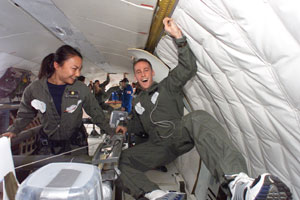|
HOME | SEARCH | ARCHIVE |
|
Students board ‘vomit comet’ to test their plan for reducing bone loss in space
![]()
By Robert Sanders, Public Affairs
| |  Bev Guo works the treadmill aboard a NASA research plane, as fellow student Chris Hamerski enjoys the pleasures of zero gravity. Photo courtesy of NASA |
09 May 2001
|
For a brief time during February, Diana Chai was her own guinea pig. Strapped to a treadmill in a NASA research plane, she calmly jogged in place as the plane executed a series of zero-G dives 50,000 feet over central Texas. “It was amazing, the best experience ever,” said Chai, a junior majoring in bioengineering. “And I didn’t even throw up.” Chai, 20, and three other campus students participated in a special NASA program that gives college students access to one of its unique assets, a research plane, often referred to as the “vomit comet,” that simulates the weightlessness of space. The NASA Reduced Gravity Student Flight Opportunities Program has operated since 1995 out of NASA ‘s Johnson Spaceflight Center in Houston. Chai and her co-scientists, the first Berkeley students to apply for the program, proposed to test an improvement to the treadmills that astronauts pound in space in order to prevent bone loss and potential injury. Without such high-impact exercise, astronauts can lose as much as three percent of their bone mass per week. Chai and three student colleagues performed the tests during two series of 30 zero-G dives, each 30 seconds long, at Ellington Field near Houston. Preliminary results indicate it was a success. “This was a very challenging project to pull off, but they did it, thanks to an enormous amount of help from NASA people,” said Rodger Kram, a former assistant professor of integrative biology who served as their faculty adviser. The idea behind treadmills in space is to mimic the pounding and leg stresses astronauts would experience while walking or running on Earth, in hopes of preventing the bone deterioration seen on long space flights. Those in use today are not very effective, primarily because they rely upon awkward and uncomfortable rubber bands to pull astronauts down onto the treadmill as they run, said Kram, now at the University of Colorado, Boulder. The elastic straps hurt so much that astronauts run in a crouched position with bent knees. While this is less painful, “they’re not banging their bones the way they need to,” Kram said. Based on laboratory experiments with simulated reduced gravity, Kram and his colleagues recently showed that runners could increase peak impact forces while using only a moderate downward pull from the shoulder straps if, at the same time, another rubber band pulled them forward. In an article in the May 2001 issue of the Journal of Biomechanics, Berkeley graduate student Young-Hui Chang, Hamerski and Kram provide convincing evidence that this forward-pulling harness works. “We’ve shown that you can increase the functional loading a runner experiences and mimic what they experience on Earth,” said Chang, now a post-doc at Emory University in Atlanta. “Now it’s up to NASA to give it a try and see if impact forces comparable to those on Earth actually prevent bone loss.” “This project is going somewhere,” said Kram. “It’s not very fancy, but it seems to be one of the more promising solutions to bone loss during long-term space flight.” For links to online photos, check www.berkeley.edu/news, the campus’s News & Events Web site.
Home | Search | Archive | About | Contact | More News
Copyright 2000, The Regents of the University of California.
Produced and maintained by the Office of Public Affairs at UC Berkeley.
Comments? E-mail berkeleyan@pa.urel.berkeley.edu.